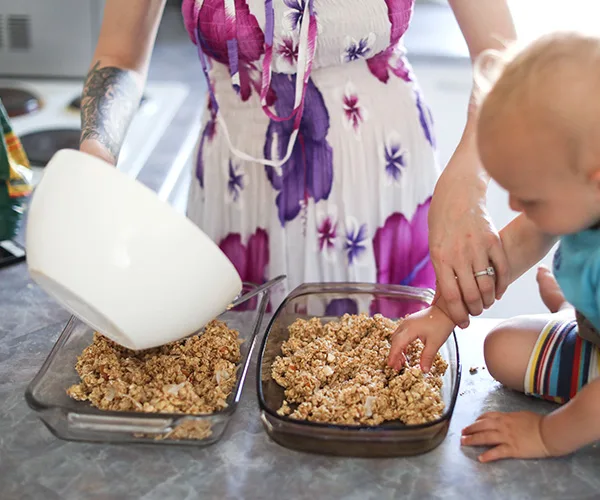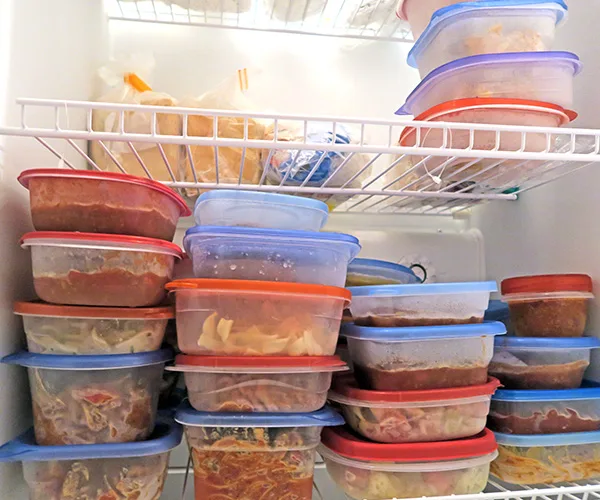It’s a scenario we’ve all faced- after a long day of work/running after the kids/who knows what else, you look in the fridge and see nothing to eat so you hop on to Uber Eats.
But of course, by regularly relying on takeaway it’s not only bad for our health, but also our bank balance.
READ NEXT: Can carbs help you lose weight? A dietitian answers your questions.
Luckily, there is a way to stay prepared and keep your health on track when it comes to eating.
Dietitian and SunRice Health & Wellbeing ambassador Lyndi Cohen chatted exclusively to Now To Love about how meal prepping isn’t as tough and as time-consuming as you may think and how it can help you get back on track with healthy eating whether you want to improve your cooking skills or shift a few kilos.
Meal prepping isn’t as tough and time-consuming as you may think.
(Image: Instagram @nude_nutritionist)“Meal prepping eliminates how reliant we are on cravings so if there’s food already prepped, then we’re more inclined to eat what’s already been made,” she explains.
“Often whenever we come home from work or wherever we’ve been for the day and we’re exhausted, the last thing we feel like doing is going shopping, finding the ingredients and cooking a healthy meal, we’re much more inclined to get takeaway. But when we dial in our dinner for takeaway, we end up spending more and sometimes it can be twice as expensive as anything you cook at home.”
Keep scrolling for her her top tips!
Get in control of your weight and healthy eating with these easy meal prep tips.
(Image: Instagram @nude_nutritionist)1. Start off small
Meal prepping may seem like a daunting, laborious process, but you don’t have to go from zero to one hundred.
“Start with one recipe,” suggests Lyndi. “It’s so easy to get overwhelmed thinking you have to do every meal for the entire week.”
Get the ball rolling by making a batch of healthy granola that will take 10 minutes and provide you with breakfast for a week or two and work your way up from there.

Try making a healthy granola for the week’s breakfasts.
(Image: Getty Images)2. Look out for special deals at the supermarket
When you meal prep, you automatically save your moolah because not only are you buying your groceries in bulk, but the meals you make can be frozen and stored for later so you’re not wasting food.
“Buy in bulk, buy what’s on discount and shape your meal prep around it,” Lyndi says.
Check out which fruits and veggies are in season depending on the time of year here.
WATCH BELOW: How to freeze leftovers. Post continues after video…
3. Fill your pantry with meal prep staples
When it comes to buying healthy ingredients, you don’t just have to limit yourself to fresh salads.
Lyndi recommends using cheap, long-lasting staples that can be found in the frozen and tinned aisles. Think frozen veggies and berries, canned tuna, chickpeas, lentils and beans and what Lyndi calls pantry heroes- things that add a lot of flavour with little effort like curry paste, coconut milk, olives and feta for example.
“Tinned tomatoes are just as healthy as the fresh stuff, and so much more convenient and so affordable,” she adds.
“They contain something called lycopene which is an antioxidant that’s really good for our heart health. It’s also such an easy way to sneak in another serve of vegetables into all the foods you cook especially meal prep recipes as tomatoes freeze so well in curries, casseroles, soups and for a dollar a tin you’re getting a lot of nutrition and bulk for your meals.”
She also suggests stocking up on wholegrain rice as it’s “easy to eat, super affordable and most people don’t know that you can actually freeze rice.”

Rice is not only easy to eat and cheap, but it’s freezable too.
(Image: Getty Images)4. Snack prep as well as meal prep
It’s not just meals that can be made in advance- be the envy of your colleagues and prep your snacks too.
“Try boiling a dozen eggs and keep them in the shell and that’s a high protein, wholefood snack,” suggests Lyndi. “And that reduces the amount of processed food and packaging too.”
You can even make marinades and dressings in advance in a jar and pop them in the fridge for later in the week.
5. Don’t forget to label your dishes
Meal prep is great for weight loss as you have portion controlled meals ready to go in the freezer to defrost when you want.
But sometimes when they’re all in the freezer, it’s hard to tell which dish is which. Especially if you’ve prepared different meals for different family members.
To avoid this issue, label your containers so you know exactly what’s on the menu for you tonight.

Not sure what’s what? Label your meal prep so you can identify your dishes.
(Image: Getty Images)6. Introduce an ‘Eat Now’ tray into your fridge
“One of the things that drives up the grocery bill is when we buy food we don’t end up eating and it goes to waste,” explains Lyndi.
“An Eat Now tray is where you put produce that looks like it needs to be eaten soon so every time you open the fridge, you’ve got to go to that tray first.”

